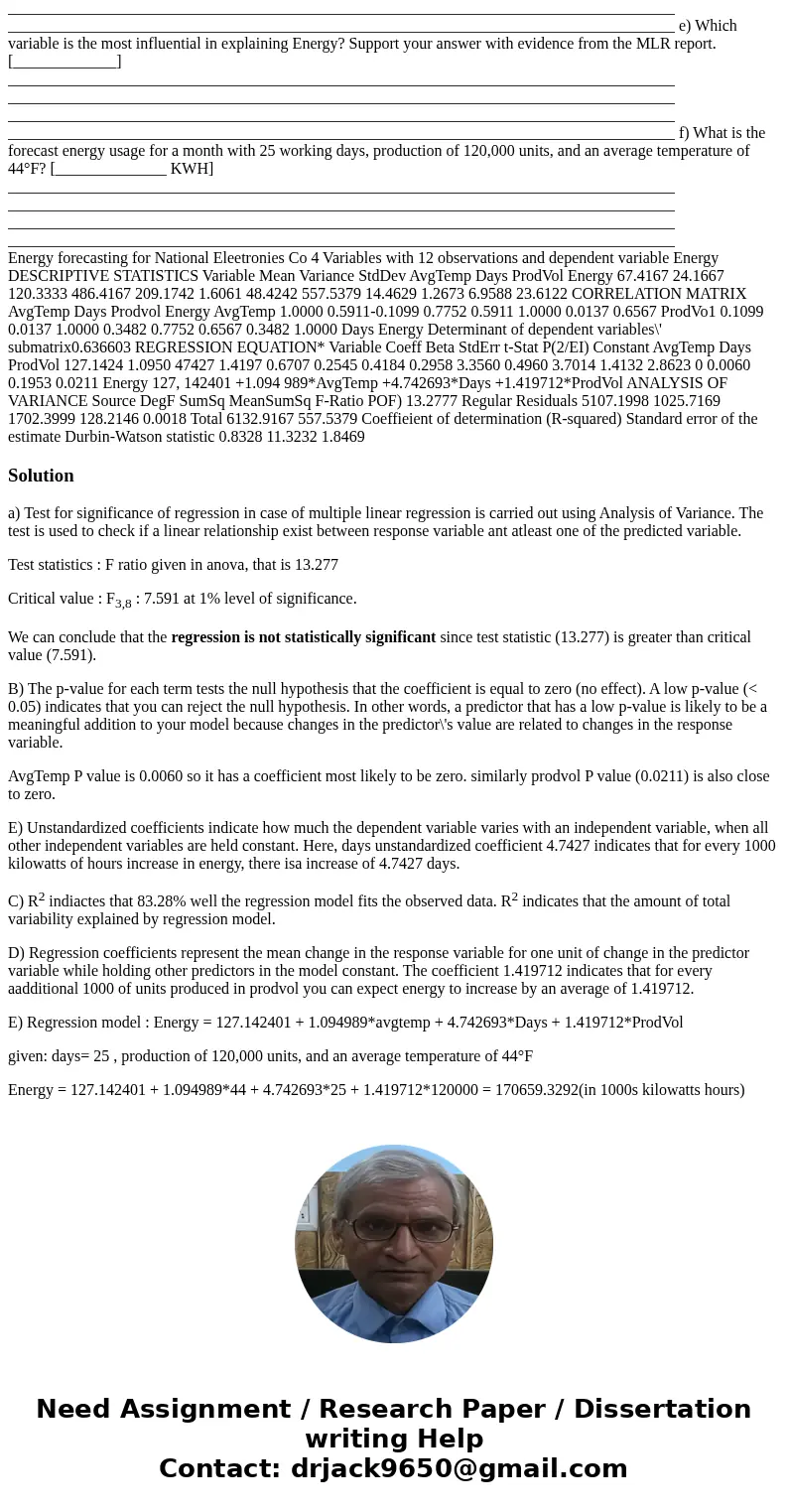The Energy Conservation Committee at National Electronics Company (NEC) is trying to understand energy use at their plant. As a first step, the committee desires a model to predict monthly energy usage (Energy, in 1000s of kilowatt-hours) as a function of: • AvgTemp, average outside temperature (in °F), • Days, number of workdays in the month, and • ProdVol, production volume (in 1000s of units produced). Data was collected and processed by the MLR program, resulting in the output on the following page. Based on this report, answer the following questions. a) Is the regression statistically significant? [____] Support your answer with persuasive evidence from the MLR report. ____________________________________________________________________________________ ____________________________________________________________________________________ ____________________________________________________________________________________ ____________________________________________________________________________________ b) Which of the independent variables has a coefficient that is most likely to be zero, and why? (Justify your answer with values from the MLR report.) ____________________________________________________________________________________ ____________________________________________________________________________________ ____________________________________________________________________________________ ____________________________________________________________________________________ c) What does the 0.8328 coefficient of determination mean? ____________________________________________________________________________________ ____________________________________________________________________________________ ____________________________________________________________________________________ ____________________________________________________________________________________ d) Explain the regression coefficient “1.419712” to a non-technical company executive. ____________________________________________________________________________________ ____________________________________________________________________________________ ____________________________________________________________________________________ ____________________________________________________________________________________ e) Which variable is the most influential in explaining Energy? Support your answer with evidence from the MLR report. [_____________] ____________________________________________________________________________________ ____________________________________________________________________________________ ____________________________________________________________________________________ ____________________________________________________________________________________ f) What is the forecast energy usage for a month with 25 working days, production of 120,000 units, and an average temperature of 44°F? [______________ KWH] ____________________________________________________________________________________ ____________________________________________________________________________________ ____________________________________________________________________________________ ____________________________________________________________________________________
Energy forecasting for National Eleetronies Co 4 Variables with 12 observations and dependent variable Energy DESCRIPTIVE STATISTICS Variable Mean Variance StdDev AvgTemp Days ProdVol Energy 67.4167 24.1667 120.3333 486.4167 209.1742 1.6061 48.4242 557.5379 14.4629 1.2673 6.9588 23.6122 CORRELATION MATRIX AvgTemp Days Prodvol Energy AvgTemp 1.0000 0.5911-0.1099 0.7752 0.5911 1.0000 0.0137 0.6567 ProdVo1 0.1099 0.0137 1.0000 0.3482 0.7752 0.6567 0.3482 1.0000 Days Energy Determinant of dependent variables\' submatrix0.636603 REGRESSION EQUATION* Variable Coeff Beta StdErr t-Stat P(2/EI) Constant AvgTemp Days ProdVol 127.1424 1.0950 47427 1.4197 0.6707 0.2545 0.4184 0.2958 3.3560 0.4960 3.7014 1.4132 2.8623 0 0.0060 0.1953 0.0211 Energy 127, 142401 +1.094 989*AvgTemp +4.742693*Days +1.419712*ProdVol ANALYSIS OF VARIANCE Source DegF SumSq MeanSumSq F-Ratio POF) 13.2777 Regular Residuals 5107.1998 1025.7169 1702.3999 128.2146 0.0018 Total 6132.9167 557.5379 Coeffieient of determination (R-squared) Standard error of the estimate Durbin-Watson statistic 0.8328 11.3232 1.8469
a) Test for significance of regression in case of multiple linear regression is carried out using Analysis of Variance. The test is used to check if a linear relationship exist between response variable ant atleast one of the predicted variable.
Test statistics : F ratio given in anova, that is 13.277
Critical value : F3,8 : 7.591 at 1% level of significance.
We can conclude that the regression is not statistically significant since test statistic (13.277) is greater than critical value (7.591).
B) The p-value for each term tests the null hypothesis that the coefficient is equal to zero (no effect). A low p-value (< 0.05) indicates that you can reject the null hypothesis. In other words, a predictor that has a low p-value is likely to be a meaningful addition to your model because changes in the predictor\'s value are related to changes in the response variable.
AvgTemp P value is 0.0060 so it has a coefficient most likely to be zero. similarly prodvol P value (0.0211) is also close to zero.
E) Unstandardized coefficients indicate how much the dependent variable varies with an independent variable, when all other independent variables are held constant. Here, days unstandardized coefficient 4.7427 indicates that for every 1000 kilowatts of hours increase in energy, there isa increase of 4.7427 days.
C) R2 indiactes that 83.28% well the regression model fits the observed data. R2 indicates that the amount of total variability explained by regression model.
D) Regression coefficients represent the mean change in the response variable for one unit of change in the predictor variable while holding other predictors in the model constant. The coefficient 1.419712 indicates that for every aadditional 1000 of units produced in prodvol you can expect energy to increase by an average of 1.419712.
E) Regression model : Energy = 127.142401 + 1.094989*avgtemp + 4.742693*Days + 1.419712*ProdVol
given: days= 25 , production of 120,000 units, and an average temperature of 44°F
Energy = 127.142401 + 1.094989*44 + 4.742693*25 + 1.419712*120000 = 170659.3292(in 1000s kilowatts hours)


 Homework Sourse
Homework Sourse